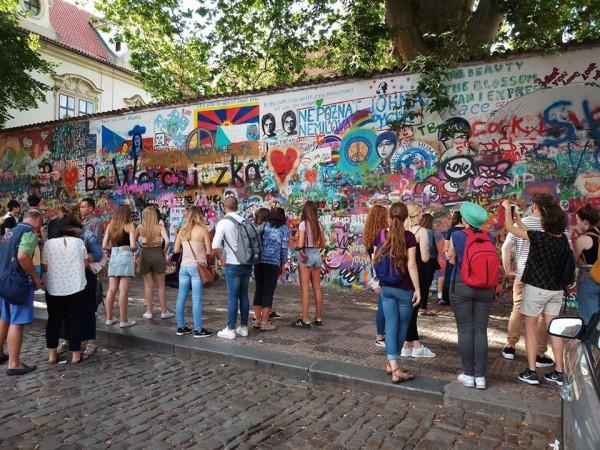
In India, when we say "the wall" in public discourse, we generally refer to former Indian cricket captain Rahul Dravid for his impenetrable batting. But in Prague, the wall makes John Lennon, the famous English singer-songwriter-activist, relevant in a conversation. And like the Indian wall, the Prague wall also stands impenetrable, in terms of spirit for freedom.
Although Lennon, who lived on this planet for just 40 autumns, did not ever visit the capital of the Czech Republic, his name is taken every moment in the picturesque city, courtesy the wall. And when I witnessed it, the feeling was, to say the least, exciting. For a first-timer in the historic city of Prague, it was equivalent to witnessing history from close quarters.
The special wall, known as the John Lennon Wall, is located Velkopřevorské náměstí in Mala Strana, which is not far from the French Embassy in Prague. Once an ordinary wall, it came to be associated with Lennon since the 1980s when people started treating it as a symbol of liberty by painting it with graffiti inspired by the iconic singer and lyrics from the unforgettable Beatles.
But why the wall was chosen as a platform to express liberty?
Lennon was a hero for the youth of central and Eastern Europe when the totalitarian rule of the communists was underway and the iron regimes had banned western pop songs, including those sung by Lennon, for he was a man who backed freedom. Some musicians were even put behind bars for playing Lennon's songs.
After Lennon's death, his legacy only strengthened in Prague
After Lennon's murder in December 1980, his legacy only became stronger and some of his followers painted a picture of him on this very wall, along with graffiti, caring little for the regime of Gustáv Husák, the long-serving communist president of the erstwhile Czechoslovakia. It was quite a risk taken by the young supporters since Czechoslovakia in those days was not known to have a space for expressing free speech.
A cat-and-mouse game began soon after the people started drawing and painting their own feelings on the wall. The state police swung into action as well to clean up the wall but never succeeded in keeping it clean for long. "Each time they whitewashed the wall, the supporters arrived to make new paintings and this went on till the authorities gave up," a local guide told me.
A monument of free speech and symbol of non-violence
The John Lennon Wall thereafter remained a monument of free speech and a strong symbol of non-violence against a strong totalitarian regime. Many in Prague believe it is the Czech equivalent to the historic Berlin Wall and that it had played an instrumental role behind the Velvet Revolution that saw the fall of communism in Czechoslovakia in 1989.
The Lennon Wall in Prague has undergone reconstruction all these years but the fabulous mix of colourful images on its surface represent the ideals that dreamers of a free world wish to achieve. Even someone has drawn a flag of Tibet on the wall to show solidarity with the movement in distant China which proves that geography poses no barriers to those who eye a world free of restrictions.
The Lennon Wall is not far from Malostranska (green line A) metro station and the Anglo-American University. It is owned by the Knights of the Maltese Cross, who have allowed graffiti, and hence history, to continue.
















